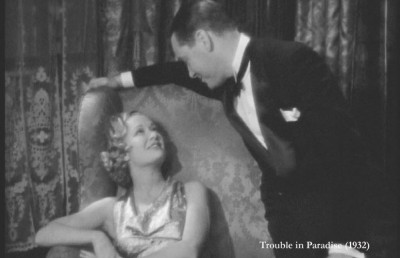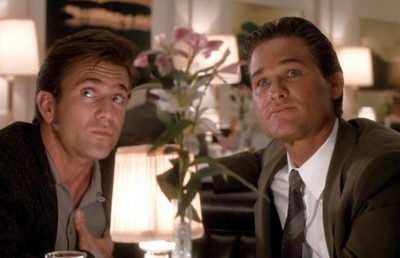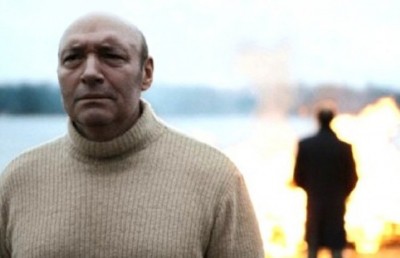The Americans Go Green at Fantasia 2007
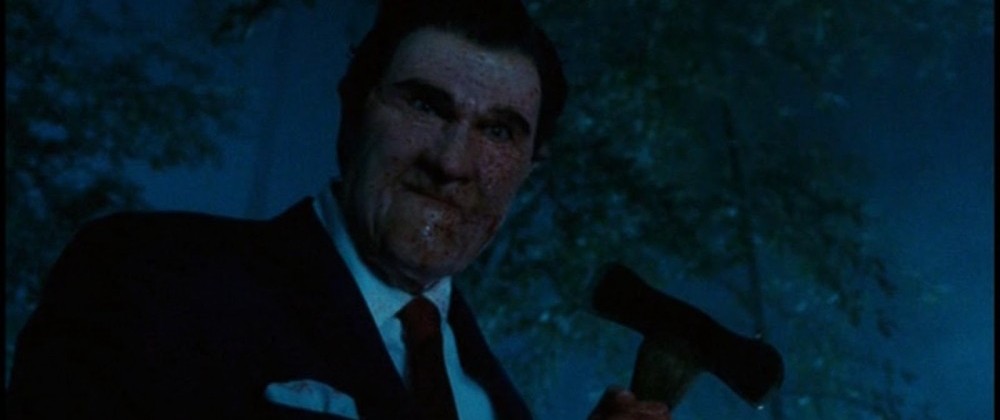
Whatever your thoughts may be on the subject of global warming, there can be little doubt that the world is currently suffering a number of environmental crises at the hands of humankind. No surprise, then, that anxieties surrounding these crises are adopted as subject matter for films in and around the thriller/horror genres; wherever there is an anxiety, there is a scary movie ready to exploit it. No surprise either that a festival such as Fantasia would harbour a concentration of such exploitation. But this year seems even more concentrated than years past, perhaps reflecting the increasing status of the environment as a hot topic in US politics. So this year my report will focus on a string of American films that foreground environmental issues and which engage with these issues to varying degrees of success.
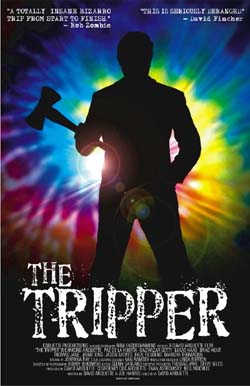
This year’s flagship film on the blending of environmental issues with politics would have to be David Arquette’s The Tripper. Here a psychopathic Reagan look-alike stalks the redwood forests of California while a music festival takes place within their depths. As a child growing up in the Regan era, the killer saw his logger father get arrested while coming to blows with a group of activists trying to prevent the destruction of some old growth trees. With a sick mother needing medication and a father struggling to pay the bills, the child saw this confrontation as the last straw. As his father was dragged off the scene in hand-cuffs for pulling a gun, the boy grabbed a chainsaw and laid into one of the protesters.
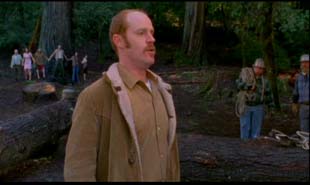
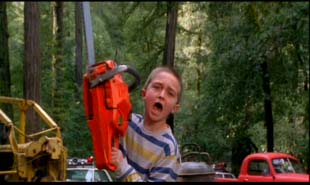
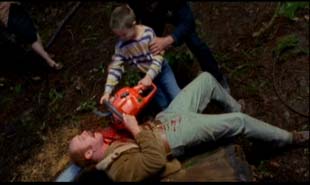
The boy was then hauled off to a mental asylum, but as fate would have it, Reagan’s cuts to the mental health program set him free and he has been enacting his vengeance upon the environmental activists of the world ever since. Fast forward a couple decades and the “Free Love” music festival in killer Ronnie’s neck of the woods has brought the hippies out in droves; he’s got his work cut out for him.
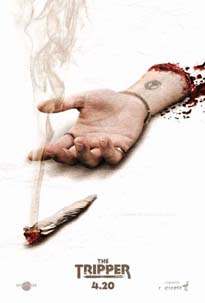
Tying this killer’s acts of vengeance to Reagan’s horrible record on the environment is funny, but unfortunately Arquette didn’t think much past the hilarity of the premise. Once the killer starts his work, he slays indiscriminately. Yes, he kills the hippies. But he also kills the cops trying to keep the hippies in line and who have just as much disdain for the environmentalists as the killer himself. And he also kills local logger hicks, the sleazy concert promoter (played by Paul Reubens) who wants only to profit from the hippie patronage of his pseudo-woodstock affair, and he even kills a fellow Republican who has come to the festival in search of his recently estranged girlfriend. It seems everyone in this film is against the hippies, and yet Reagan kills them all. Why? There are a couple of easy answers to the killer’s behaviour. One is that he’s crazy, so nothing he does makes any sense. That one’s too easy. Another is that the killer is emulating Regan’s policies which, although targeting the environmental movement specifically, end up hurting everyone. This is more interesting, but the film makes no effort to offer this as an explanation. In the end, the killer’s indiscriminate rampaging undermines the film’s potential to play out as astute political commentary. While the film is rather well made with some really beautiful forest photography and inspired set-pieces, it falls short of the mark it sets out for itself.
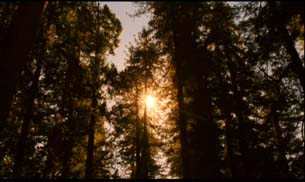
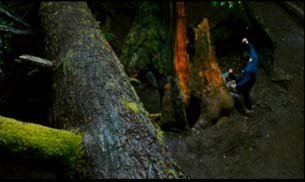
Even if the film doesn’t engage substantially with the issues it raises, at least it provides some food for thought. One powerful sentiment expressed about midway through the film comes when one of the hippie-haters explains his position: “I hate ‘em because they made it so that a tree is more important than a man’s life.” This sentiment is echoed by Courtney Cox whose cameo entails her being mauled by killer Ronnie’s attack dogs. While being rescued at the expense of the dogs’ lives she exclaims: “Wait! These are God’s creatures!” It was very funny, and points to one of the deep running undercurrents of anti-environmentalist mentality: that humans are the dominant creatures of the earth, and that everything else must be sublimated to their needs.
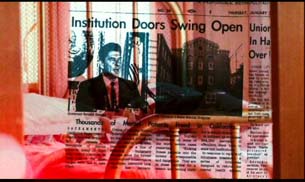

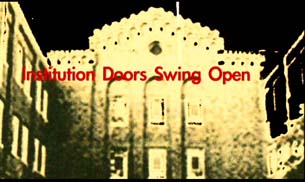
Another of the film’s running themes is that of Reagan’s policy on the mental health system. In the Q+A that followed the film, Arquette mentioned that he was partly inspired by his experience as a boy growing up in the more “hoody” parts of L.A. (poor David) just after Reagan closed down a large number of the mental hospitals in the US, throwing vast quantities of these patients out into the streets to mingle with the general populous. Thus The Tripper can be read as a commentary on the negative implications of Reagan’s policy for the general population. What isn’t addressed, of course, is the fact that part of the problem is the way contemporary society handles so-called mental disability. We’ve created a normalizing view of the proper parameters for behaviour that society can tolerate, and if you step too far outside these bounds then you need to be locked up. This can be true of a murderous psycho, or someone far more benign who simply can no longer function in the 9 – 5 world because of certain differences that position them outside the norm. So the film is symptomatic of the extreme view that anyone with what we call mental disabilities has the potential to be an axe-wielding maniac. But again, the film does not address this issue, and instead simply takes this social anxiety and lets it loose as so many other slasher films have done before.

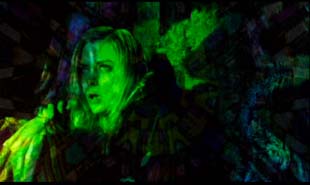
Finally, the drug angle is also front and center in The Tripper, with many of the principal characters being under the influence of various hallucinogenic substances throughout much of the film. Of course Reagan’s “Just Say No” campaign is a major source of inspiration for the film, but again Arquette fails to really embrace the spirit of this inspiration. Clearly no stranger to experimentation with substances, it’s a shame that Arquette’s experience didn’t translate into the aesthetics of the film. There are hints at psychedelia here and there, with some rainbow colour schemes, a few filters, and a couple bursts of kaleidoscopic montage. But in general, the film is clearly playing down its own subject matter to try and please the mainstream. Just as there was potential for much deeper level of engagement with political commentary, so too was there potential for visual experimentation that could have yielded a true psychedelic experience rather than simply alluding to one. After all is said and done, it is the film’s end credit sequence that is most inspired: a montage of newspaper clippings and audio excerpts detailing Reagan’s appalling record on the environment. At least they saved the best for last.
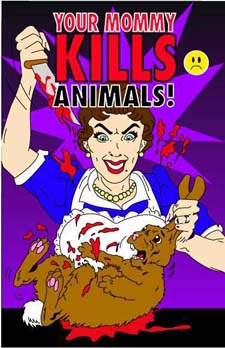
The notion that a tree’s life is more valuable than a human’s is echoed in the truly outstanding documentary Your Mommy Kills Animals, though here it is the love of animals that often takes precedence over humans. Indeed, certain virulent strains of animal activism do endanger human lives in order to save those of our mistreated furry cousins, prompting one perturbed interviewee to conclude that the animal rights movement is a hate movement: “In order to love animals you have to hate people.” Perhaps this is one of the reasons why a group like the Animal Liberation Front can make it to the top of the Pentagon’s list of domestic terror threats, ranked higher even than Al Qaeda (though what this fact really indicates is the Patriot Act’s position on activism of any sort, with protesters grouped into the category of terrorists so that anyone demonstrating in public can be arrested and held as though they were a member of a terrorist organization). Yet what I like most about this thorough documentary is that the filmmakers clearly differentiate between various different activist factions and go into great detail about the differences in their approaches. And, even more importantly, it emphasizes how the act of generalizing about animal activist activity can end up causing more harm than good. The story revolves around two activists who end up being handed fairly heavy sentences based not on their actions, but on the public perception of the intentions behind animal activism in general (which are fostered by the kind of hysteria created by government policy). If the jury had had the chance to see this documentary before rendering their verdict, perhaps their view of the situation would have been different. At the same time as it sheds light on the more benign practices of some activists, the film also exposes faults in popular agencies like PETA who, according to statistics, have a far worse record for killing animals taken into their protective custody than the SPCA and other shelters. If anyone wants to understand the ethical and legal issues pertaining to the animal rights movement then this is a must see. And ultimately the film speaks to the culture of activism in general and its position in a country growing increasingly paranoid about its own citizens and their concerns for lives other than those of human beings.
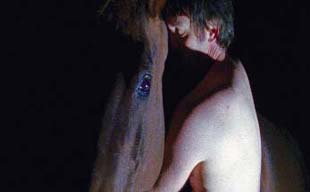
Indeed, not all animal lovers are cut of the same cloth, and nowhere is this more evident than in another documentary highlight of the festival: Zoo. As an insider’s look at zoophilia, this film documents animal love taken to the extreme. This highly stylized exploration of the controversies surrounding human sexual activity with animals uses actors portraying the real persons whose stories are told in the film, and nothing explicit is ever shown. Yet the first half of the film is based on the aesthetic principle of keeping the actors’ faces obscured by shadow, and constructs all of its scenes so that the lighting set-ups and character movements keep these figures lurking in the darkness as we hear voice-over interviews with the real subjects discussing their practices along radio news reportage about the events discussed in the film. Not until a detective is interviewed in stark lighting about midway through the film do we see someone positioned in plain sight speaking in his own voice, a strategy which clearly sets the law apart from the zoophiles. The whole thing is very artfully done, and for this reason it’s a shame that the 35 mm print didn’t show up in time for the screening. The video copy they had was relatively good, but because of the aesthetic importance of deep blacks and shadow detail to the theme of zoophiles living their lives in obscurity, this film would have benefited greatly from a nice print.
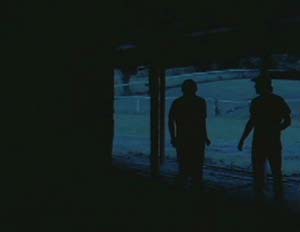
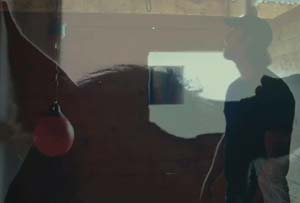
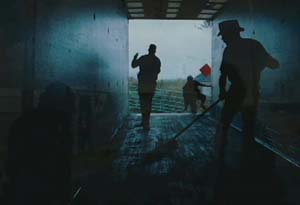
At the heart of the controversy is the issue of animal consent. The film begins with a news story of a man who was killed while on the receiving end of anal intercourse with a horse. The argument is made that the horse is abused because it hasn’t consented to the act. Now, if the horse was restrained and being forcibly penetrated then I could buy that argument. But, as is addressed by Rush Limbaugh’s radio commentary excerpted in the film, how do we know the horse didn’t consent? Could the horse be made erect by force and then coerced into engaging with the man? It seems to me that one could describe this as a consensual act on the part of the horse, regardless of whatever moral judgments one wants to make about it. But beyond the question of coercion there lies another argument: even if physically consensual, the horse isn’t conscious enough of the situation to properly judge the rightness of his actions or understand their implications. But this presumes a typical “man over beast” view of animal consciousness that is at best based on very limited understanding of animal minds, and at worst reflects the fundamental way of thinking that has resulted in so many of the environmental catastrophes that are currently facing the planet. So while taking a horses’ cock up the ass might not be the answer to solving the animal rights issues fought for by the kinds of activists portrayed in Your Mommy Kills Animals, the issues that such activities raise certainly point to important questions about our attitudes towards the animal kingdom and our relationship to it. And when the solution posed by authorities is to confiscate the horse and castrate him so that he won’t be able to engage in such activities any further, one wonders where the abuse really lies. Zoo does a good job at navigating these issues. If a tad biased in favour of the accused, the film remains but a door into a world that most of us would seldom think about, and offers us the chance to try and understand – even if we don’t give our blessing.
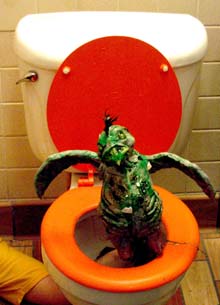
As though in answer to the abuse that so many of the world’s animals endure, this year’s festival showed no signs of shortage on the “diseased animal takes revenge on humanity” premise. One of the most anticipated of this year’s diseased animal crop was Troma’s Poultrygeist. A musical zombie satire, here we find a fast food joint built over an “Indian Burial Ground” causing chickens destined for the fryer to come back to life and wreak havoc on their aggressors. Meanwhile, a protest group calling itself CLAM – Collegiate Lesbians Against Mega-Conglomerations – sings its heart out in the parking lot outside.
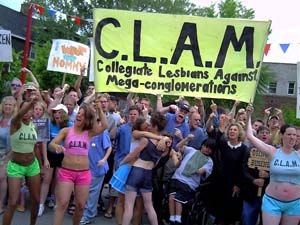
Directed by Llody Kaufman himself while also playing multiple roles in the film, Poultrygeist boasts as much blood and boob content as any title in their catalogue. But as usual, stiff competition for the film itself was given by the live appearance of Kaufman and the Troma crew during their introduction of the film and the Q+A that followed. Before the film started, Lloyd was greeted with a standing ovation. His adventures at Fantasia have been well received, regularly joined by a mob of Troma characters bouncing around the stage in costume. This time, to commemorate the 10 years that Troma has been attending the festival, Lloyd announced to the audience that the Toxic Avenger that has been at his side for each Montreal appearance is none other than the festival’s own notorious stage-hand Daniel! Surprise surprise. Though the most in the crowd were old enough to handle the great unmasking, Kaufman was kind enough to make sure, prior to the announcement, that there were no children present lest their beliefs in the existence of Toxie be smashed to pieces along with the truth about Santa Claus. Then he thanked the producers for their fine job on this particular film, followed by a French translation in which he took the comment back and suggested that they were, in fact, terrible and that he made the movie entirely by himself.
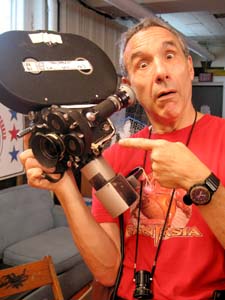
On the whole it was another strong outing for the Troma crew, who also presented a live cabaret-style variety show the night before to a sell-out crowd. While Poultrygeist offered pretty much what you’d expect from Troma (read: not much in the way of intellectual content), the film did manage to touch on issues of colonial land seizure at the hands of multinational corporations who propagate ill health through the mass marketing of toxic foodstuffs, thus tying in quite nicely with the set of films dealing with environmental issues this year.
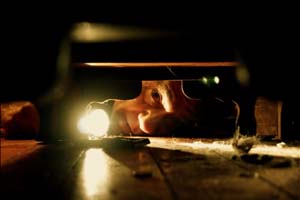
Poultrygeist was well positioned after the premiere of Mulberry Street, a super low-budget yet high production-value take on the zombie genre which again touched on some of the environmental issues facing Americans in the 21st Century. With his legendary enthusiasm, festival programmer Mitch Davis introduced the film as his favourite American indie horror film of the last several years (a statement that Lloyd Kaufman spoofed shortly afterwards when he introduced Poultrygeist as “Mitch’s favourite American indie film of the last week –correction, the last hour!” Indeed, the connection between the two films was thematically quite strong, if not aesthetically. Poultrygeist was, in part, inspired by the fact that the Troma offices became infested with rats soon after a McDonalds moved in across the street. This made for a nice tie-in to ??Mulberry Street??’s theme of diseased rats out to lay waste to humanity, though this film was set to a darker tone than the Troma outing. Here, director Jim Mitchell says, the rat is used as a symbol of urban decay, and everything that has gone wrong in New York City as a result of gentrification. Along with gentrification comes the problems of the forgotten middle class, doomed to becoming wiped out and relegated to those corners of the urban environment reserved for those who can’t make it into the upper echelons of a society structured by the new world economy. And so, when the city becomes infested with diseased rats that turn people into rodent-zombies, the government leaves them to die Katrina-style.
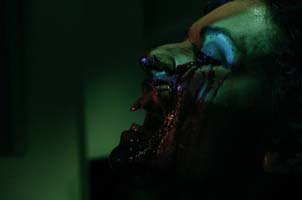
The film also comments on the various wars the U.S. is currently engaged in overseas. One of the principal characters is a young woman just home for a tour in Iraq, only to find her beloved city torn apart by mutant rat-people with no help in sight. Without being overly explicit about it, the film manages to question the point of fighting for a better world overseas when the one at home on domestic soil is left to rot. And there’s no escaping the 9/11 references inherent in the film’s play on New York City as site of urban destruction. The film looks really slick for the low low budget it was produced with, and delivers effective genre-specific thrills while still managing to make a statement about the fate of urban centers in the face of the increasing gap between gentrification and neglect. If cities are to harbour the bulk of humanity’s communities in the new century, then the question of crisis-management must be put front and center. As we’ve seen off-screen, the U.S. government picks its crises carefully, leaving many to manage themselves. Follow the money to figure out which crises belong in what category.
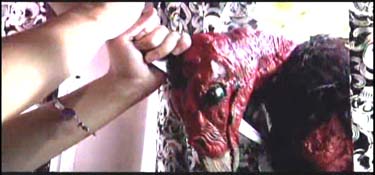
As well crafted as Mulberry Street was, first prize for sheer energy in the diseased animal sector must go to The Rage, an absolutely relentless journey through amazing old-school splatter effects work directed by Robert Kurtzman of the legendary KNB effects house responsible for a great many horror classics of the past couple decades. Though shot mostly during the day for lack of a lighting budget, the film only benefits from having its monsters in plain sight. Unlike the usual scenario followed by Poultrygeist and Mulberry Street, wherein humans get infected and zombified after getting attacked by diseased animals, this time all hell breaks loose when some infected humans pass their contagion along to a pack of vultures. The rest is history, with some of the most visceral hunter/hunted chase scenarios in horror film history. The film’s premise also boasts some political commentary: the virus unleashed into the animal kingdom is the result of revenge against the capitalists sought by a Soviet doctor whose cure for cancer was bought out and suppressed by multinational drug companies after the collapse of the Union. Without any acknowledgment or financial reward for his long years of research, he begins testing his revenge virus on human subjects, only to unwittingly unleash it into the uncontrolled world beyond his laboratory –and what follows is definitely a rage. The film certainly does 80’s splatter classics proud in its embrace of latex, but it’s also notable for its impressive pacing –largely the result of deft editing and a scathing audio treatment. It’s not long before the screech of the rage-infected vultures sears a hole through your brain, and from there you’re left open and vulnerable to Kurtzman’s gore-splattered whims while you ponder the corruption of a pharmaceutical industry that would rather see people die slowly while paying for their product than allowing a genuine cure to see the light of day. The Rage is a definite must for those who like that sort of thing.
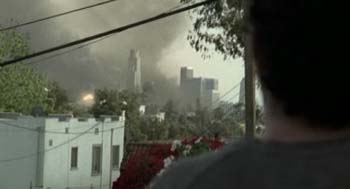
Monsters as political commentary aside, one of the most poignant and timely entries in this year’s cavalcade of environmentally motivated American genre films was Chris Gorak’s Right at Your Door. The first feature film for Gorak, he has previously been best known for his work as art director on visual masterpieces like Gilliam’s Fear and Loathing in Las Vegas, Fincher’s Fight Club, and the Coens’ The Hudsucker Proxy –and his experience on these projects shines right through to give Right at Your Door an impressive look for a fairly low-budget film. A young married couple wakes up one morning in their home just outside L.A.’s downtown core. She heads off to work while he stays home to follow-up on some want ads. A short time later, word comes over the radio that some explosive devices have been detonated downtown, and an unknown airborne substance is spreading quickly. He tries to drive downtown to find her but is forced at gunpoint by mask-wearing police to return home. After waiting some time more, he finally gives in and follows the radio’s advice to seal himself inside his house for fear of exposure to the potentially deadly substance spreading outward from the city center. Then…his wife shows up. Now he has to decide whether or not to let her in, and it is around this ethical dilemma that the film plays out while getting the audience to question what we would do in his place. He decides not to let her in. It’s a decision that comes back to haunt him, not because she is left outside to die, but because it turns out that the radio gave some bad advice…
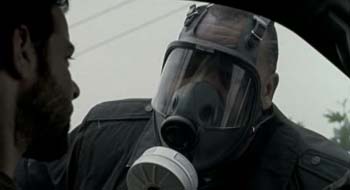
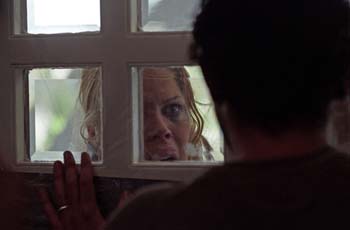
And so the film turns out to be a critique of the way that authorities handle crisis situations, and the problems the general public faces in trying to cope with disaster on a mass scale. The film’s real strength lies in the director’s handling of the tension between interior and exterior space, and their larger significance in the context of the film’s political commentary. Outside has always represented freedom, yet scores of horror films position the safety of interior spaces as a freedom from the anarchy raging on the other side of the door –only to finally throw those interior spaces open to the external world. Right at Your Door follows in this tradition nicely, while tying this pattern to the politics of the war on terror in the face of attacks on domestic soil. And aesthetically the film is impressive indeed, from the development of the atmosphere inside the increasingly cramped space of a sealed house running out of air, to the eerily deserted streets just outside sprinkled with gently falling flakes of mysterious dust. The film also makes regular use of wide-shots of downtown L.A. taken from the suburbs just beyond, showing the city and its surroundings in evolving states of cloud cover from the smoke spewing from the attack sites. Interestingly, Gorak explained in the Q+A that these shots were created from photographs of L.A. digitally composited with footage of the fires of Kuwait following the Iraq invasion of 1991. So a subliminal connection is made between terrorist attacks on domestic soil and the first Iraq war under George Bush Sr. This compositing thus mirrors the film’s main theme: can you trust a government to protect you from a danger that it had a hand in causing? As the source of the explosions is never revealed, we all remain in the dark as to what really happened to cause the events portrayed in the film. Like Gulf War Syndrome, the mysterious substance threatening American citizens in Gorak’s film might well have been the U.S. government’s own military practices rather than those of the enemy. Finally, the theme of being kept in the dark at the hands of one’s government is the grizzly note upon which the film ends.
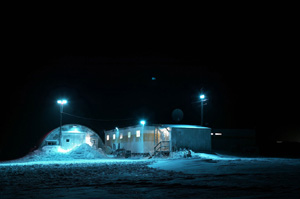
In what was likely the most environmentally conscious film of the festival, Larry Fessenden’s The Last Winter brought back the Wendigo spirit that provided the namesake of his previous outing. As a sequel of sorts, Fessenden uses The Last Winter to move the message of the First Nations legend of the Wendigo from the psychology of a young boy dealing with tense relations between his parents to the more universal problem of global warming. Here, an oil speculation team in the arctic is burdened with the presence of an environmental analyst whose findings suggest that serious warming is causing irreparable damage to the arctic ice with worldwide consequences. As a symptom of the damage, the mythical Wendigo spirits, who take the form of modified moose, have been visiting the outpost and driving the oil people slowly mad to the point of death by exposure, self-mutilation, and the like.
In the previous film, the Wendigo was created using stop-motion animation techniques to chart the development of the creature from something merely glimpsed in the woods to a full-blown figure made, in part, out of wood. The effect was impressive and, at its best, hallucinatory in a way that can only be achieved through the frenetic montage that Fessenden employed. So I was disappointed to find a much cleaner approach to the creature effects in The Last Winter wherein the Wendigo appeared as green translucent figures that drifted smoothly across the tundra. During the Q+A I asked Fessenden about the change in aesthetic, and his answer made a lot of sense. Quite simply, in the previous film the Wendigo was viewed from the perspective of a child and was thus perceived more as a kind of crude puppet with jerky motions created by the montage and the use of the hand-built costume consisting of moose-head with branchy body. In the new film, he wanted a much more fluid look to match the flow of the snow blowing across the ice with a motion inspired by the northern lights visible in the region. And I agree that the CGI work was indeed effective in this regard. But on purely aesthetic terms, I prefer the earlier invocation, especially when it comes to the full monster reveal. As mysterious ghost-like figures passing in the night, the CGI approach works well. But once we see a full-blown Wendigo towards the end of the film, it starts to look more like a graphic than an organic entity. However, one might argue that the Wendigo props used in the previous film are equally unsuccessful when brought into full view. It just feels to me as though his first approach was more about cinematic technique than his second, the Wendigo being evoked as a function of the medium itself rather than an excursion into new digital technologies. But here I’m about to get embroiled in the debate surrounding the nature of cinema in the digital age, and I won’t go any further with that here.

The film is a passionate exploration of the metaphysical side of the global warming issue, and Fessenden’s personal engagement with spreading awareness of the cause gives the film a thematic depth that is absent from some of the other films I’ve mentioned thus far which often tend to use environmental politics as a premise upon which to unleash a fury of genre mayhem without probing too far into the issues and questions raised by these politics. Fessenden, on the other hand, has been an active environmental crusader for some time, and the level of his engagement is apparent upon a visit to the website for his production company Glass Eye Pix along with his activist site: Running Out of Road. While working on his first feature film –the animal rights motivated horror outing No Telling??– Fessenden wrote Low Impact Filmmaking: A Practical Guide to Environmentally Sound Film and Video Production, using his practices on ??No Telling as a case in point. Indeed, the mandate of Glass Eye Pix revolves around a sense of community responsibility, not only with respect to the natural world but also in terms of the spirit of artistic collaboration and the relationship between artists, their body of work, and their public. And messages related to all these concerns can be found embedded in The Last Winter, while still remaining a good genre film rather than potential fodder for a keynote slide in an Al Gore presentation.
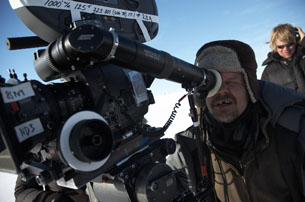
Ultimately, I think The Last Winter succeeds the most in its articulation of the tension that exists in the Western world between the human subject and its surrounding environment. In the domain of science studies, Bruno Latour has written that the issue of climate change has finally come to demonstrate the fact that what is often called “nature” is not separate from “society,” and that the two are necessarily embedded within each other. As long as the idea of such separation remains in tact, industry folks can go about extracting resources from the Earth without giving thought to the social implications of this act. What the oil exploration team in Fessenden’s arctic is on the verge of realizing is that, in the process of bringing forth the resources guarded deep within the earth, they are also pouring their own souls out into the environment. In this meeting place between inside and outside the Wendigo is born, and stands as a figure which illustrates the deep connection between individuals, their societies, and the environment in which these societies are built. As the oil team in The Last Winter struggles with what they think they’ve seen out on the frozen tundra, these specters come closer and closer – not to kill, specifically, but to remove the artificial barrier between the human and natural worlds. But when removing this barrier there comes a period of friction between these once separated domains – a friction that comes with often violent consequences. It is in this space of friction that The Last Winter stands, reflecting Fessenden’s view of the world’s position at present. The Wendigo is part human subconscious, and part spirit of the natural world in which we live. In the previous film, Fessenden evoked the spirit’s connection to the forest by treating the Wendigo with an aesthetic of wood. In The Last Winter the design of the creature is given a distinctly pre-historic flavour to invoke the dinosaurs whose bones provide the substance that drives the world economy.

In the “ecology” section of the Glass Eye Pix website, Fessenden writes: “I have come to believe that all the spiritual yearning and existential angst that drive religion and history can be resolved through a deep appreciation and empathy with the rhythms and realities of nature.” Along with appreciation for the natural world, the figure of the Wendigo suggests that a deeper appreciation of one’s own inner world is part of what is necessary to strike a balance between humans and our environments. This idea is suggested in the film’s most powerful sequence as the creature comes to haul one of the team members off on a journey across the barren tundra into the past of his memories. The line is thus drawn directly from the inside of the earth to the interior of the human psyche with the frozen desert as the landscape that smoothes out the divisions between these once separate spaces. For Fessenden, it is this borderless landscape that is threatened by global warming, the landscape that governs the balance of the world’s ecosystems just as it provides space for separate worlds to co-exist. The real message of the film is expressed in this need to break down the barriers between the individual and the environment, a message that can be appreciated even if we might be a bit turned off by the explicit nature of the film’s references to global warming as the Earth’s greatest threat. While not my favourite film of the festival, The Last Winter certainly comes out on top as the American film which takes its environmentally motivated premise to the highest level of aesthetic and narrative engagement. And Fessenden certainly deserves accolades for that.



